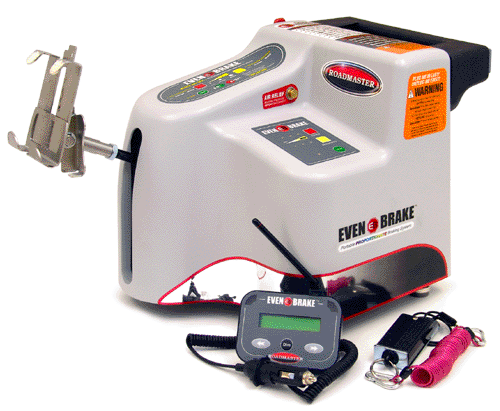You've decided to tow a dinghy, or toad, behind your motor home so you will have a practical vehicle for running errands, sightseeing in urban areas or just going to dinner at a nice restaurant. There is much more to safe dinghy towing than just hitching up the family car behind a motor home.

For starters, just about every state and Canadian province requires towed vehicles over a certain weight, which varies with jurisdiction, have an independent braking system. This can be as low as 1,000, and in some states every towed vehicle requires braking. For a complete listing of laws, click on www.roadmasterinc.com or www.brakebuddy.com. Incidentally, the police are cracking down on unsafe towing. For example, British Columbia now aggressively enforces its 3000 pound limit for un-braked towed vehicles. Not only are tickets issued, the dinghy has to be disconnected and driven out of the province under its own power.
Even if it is not required by the you will be traveling in, installing a supplemental braking system could prevent a serious accident. Also the warranty on your RV could be voided if vehicles over a certain weight are towed without a supplemental braking system. Finally, you could be legally liable if an accident was caused by improper equipment.
There are a couple of ways to add supplemental braking. The easiest approach is to use a portable auxiliary braking system like the Roadmaster Even Brakeâ„¢ or BrakeBuddy®. The more difficult approach is to use on the ties into the tow vehicle's hydraulic or air brake system.
Portable systems are installed in front of the driver's seat of the towed vehicle and attached to the brake pedal. When a sensor in the unit determines that the RV is decelerating, the unit releases air pressure to depress the brake pedal. While the Brake Buddy is a 'brakes off/brakes on' system, the Even Brake is a proportional braking system. Proportional means that the brakes on the towed vehicle are applied in unison and with approximately the same pressure as applied to the brakes on the towing vehicle.
Both units are portable and easily switched between vehicles.
For most situations, a tow bar is the best option - relatively inexpensive and little added weight. If you don't plan to tow regularly or the dinghy is very light, you can get by with a Rigid A-Frame tow bar. Cheap, but somewhat difficult to attach because the arms don't collapse or adjust. This means some jockeying to align the dinghy precisely to complete the hookup. Definitely, a two-person job.
For serious towing and a one-person job, a Collapsible or Self Aligning tow bar is a must. The self-aligning feature allows driving up close to the motor home and then lets the tow bar adjust to the vehicle's position. As you drive away, the arms extend, self-center and lock in place to provide a rigid tow bar.
Car-Mounted tow bars stay attached to the dinghy, folded up in the front. The attached tow bar does distract from the appearance of the vehicle. Also if the front of the vehicle is hit or hits something, the front end and bumper can be damaged. The somewhat heavy tow bar up front can affect handling and can be a target for thieves. Motor home- Mounted tow bars fold up at the rear of the coach. These bars do not require a ball mount and many say they are easier to handle than car-mounted tow bars.
Finally, if your towed vehicle can't be towed flat with the front wheels turning, then you will have to use a tow dolly.
You will need some practice before you hit the open road. Add a 3,000 pound or much greater dinghy behind a 7 to 15 ton motor home and stopping distances increase by 30- to 80-percent. Add that weight at the end of a flexible lever, the tow bar, and you can see why you can get into trouble if you have to make a split second maneuver at 65 mph and your equipment isn't up to job.




